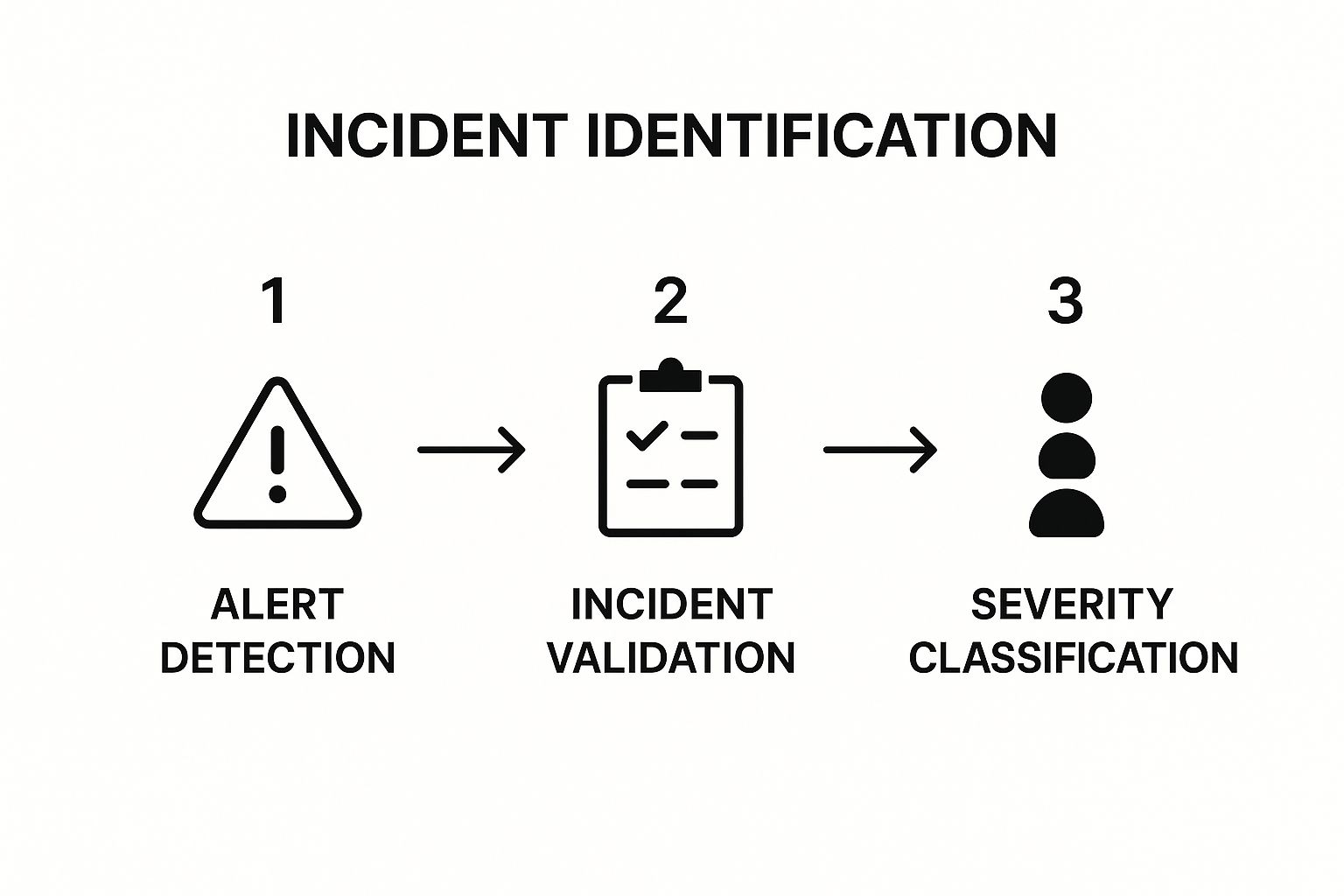At its core, an incident response process is your organisation’s guidebook for navigating the turbulent waters of a security breach or cyberattack. Think of it as the emergency action plan a flight crew rehearses—a meticulously structured protocol that ensures everyone knows their role and can act decisively to manage a crisis. This plan is what stands between a minor issue and a full-blown catastrophe.
Why an Incident Response Process Is So Critical

Imagine a fire department showing up to a five-alarm fire without a plan. No one knows who’s in charge, where the hydrants are, or what the building layout looks like. That’s what it’s like for a company facing a cyberattack without a formal incident response process. The result is pure chaos, with panicked decisions, delayed reactions, and ultimately, far more damage than necessary.
A well-defined process cuts through that confusion. It provides a clear, methodical roadmap for your team, transforming a frantic scramble into a controlled operation where every step is deliberate and focused on resolving the incident quickly and effectively.
Protecting Business Continuity and Trust
A solid incident response plan is the bedrock of business resilience. When you can contain threats swiftly, you dramatically reduce operational downtime and the financial bleeding that comes with it. But even more importantly, you’re protecting your most fragile and valuable asset: customer trust. Handling a breach with competence shows a deep commitment to security, which can help preserve your reputation even after an attack.
The numbers today make this level of preparation non-negotiable. Just look at the threat landscape in India. A 2024 analysis of around 8.4 million endpoints uncovered over 369.01 million security incidents. That breaks down to an astonishing 702 potential threats every single minute. These statistics, highlighted in the India Cyber Threat Report 2023 by Seqrite, underscore why a systematic response is no longer just a good idea—it’s essential.
To put the current risk into perspective, here are a few key statistics that highlight why a structured plan is so vital.
Why Incident Response Matters At a Glance
| Metric | Statistic | Implication for Incident Response |
|---|---|---|
| Average Cost of a Data Breach | $4.45 million globally in 2023. | A fast, effective response directly reduces financial impact by minimising downtime and data loss. |
| Breach Identification Time | It takes an average of 277 days to identify and contain a breach. | A formal process with proactive detection can significantly shorten this lifecycle, limiting an attacker’s dwell time. |
| Threats Detected in India (2024) | 369.01 million incidents across 8.4 million endpoints. | The sheer volume of threats makes a manual, ad-hoc approach unsustainable and highly risky. |
These figures aren’t just abstract numbers; they represent real-world risks that every organisation faces. A formal incident response process is the most direct and effective way to mitigate them.
Ensuring Regulatory Adherence
Beyond the operational and financial benefits, a formal process is often a straight-up legal and regulatory mandate. Many data protection laws and industry standards explicitly require organisations to have documented procedures for handling security breaches.
A documented incident response process isn’t just a technical best practice; it’s a core component of corporate governance. It proves to regulators, partners, and customers that you take cybersecurity seriously and have the mechanisms in place to manage risk effectively.
Failing to meet these obligations can lead to crippling fines, legal battles, and long-term brand damage. Properly managing these requirements is a crucial element of maintaining strong cloud security compliance and proving your organisation practices due diligence.
The Six Phases of the Incident Response Lifecycle
A solid incident response process isn’t some rigid checklist you tick off during a crisis. It’s a living, breathing cycle. Think of it less like a straight road and more like a continuous loop, where the wisdom gained from one incident directly fortifies you for the next one. This cycle is usually broken down into six distinct, yet interconnected, phases, each with its own clear job to do.
This lifecycle model, championed by organisations like the SANS Institute and NIST, gives teams a proven framework that’s both structured and adaptable. It’s the roadmap that guides your security crew from the calm before the storm to the crucial debrief after it passes, making sure no vital step gets lost in the heat of the moment.
Let’s walk through each of these critical stages.
Phase 1: Preparation
This is where the real work begins long before an attack ever lands. It’s the “ready for anything” phase. Being well-prepared is what separates a controlled, measured response from a headless, chaotic scramble. It’s all about creating your formal Incident Response Plan (IRP), putting together the right team, and making sure everyone knows their role inside and out.
Key activities during this proactive stage include:
- Building Your Team: Formally establishing your Computer Security Incident Response Team (CSIRT). This isn’t just for your tech wizards; it should include people from legal, communications, and management.
- Gearing Up: Getting your security toolkit in place and finely tuned. We’re talking about essential tools like Security Information and Event Management (SIEM), Endpoint Detection and Response (EDR), and network monitoring solutions.
- Running Drills: Practice makes perfect. Running tabletop exercises and full-blown simulations is the only way to be sure your team can actually execute the plan when the pressure is on.
Phase 2: Identification
This is the moment of truth: “Is this a real fire, or just smoke?” Your monitoring tools will throw up thousands of alerts daily, but the vast majority aren’t genuine security incidents. The identification phase is all about accurately spotting and validating a real threat separating the meaningful signal from the background noise.
The goal is to move from detection to validation and classification, making sure your team’s valuable time is spent on credible threats only.

The heart of identification isn’t just spotting an anomaly. It’s about understanding its context and potential impact. A single failed login is noise; a hundred failed logins from an unusual location targeting a key administrator account? That’s a signal you can’t ignore.
Phase 3: Containment
Once you’ve confirmed you have a real incident on your hands, the immediate priority is to stop the bleeding. Fast. Containment strategies are all about limiting the damage and preventing the threat from spreading across your network. This is a critical decision point where speed and precision are everything.
Containment might involve short-term fixes, like yanking an infected laptop off the network. Or it could be a longer-term strategy, like segmenting your network to build a digital firewall between clean and compromised areas. The right move depends entirely on the attack and its potential fallout for the business.
Phase 4: Eradication
With the immediate threat boxed in, the focus shifts to surgically removing the attacker and every trace they left behind. Eradication is about digging down to the root cause of the incident and ripping it out for good. It’s not enough to just delete a piece of malware; you have to patch the vulnerability that let it slip through in the first place.
This phase is what ensures the attacker can’t just walk back in through the same open door. It often involves a deep forensic dive to hunt down every artefact of the breach before restoring systems to a trusted, clean state.
Phase 5: Recovery
After the threat has been completely kicked out, the recovery phase begins. This is where you carefully bring affected systems and services back into normal operation. But this is no time to be hasty. You can’t just flip a switch and hope for the best.
Systems have to be brought back online in a deliberate, controlled way, with constant monitoring to ensure they are stable and secure. The recovery process often means restoring data from clean backups, rebuilding compromised machines from scratch, and triple-checking that all security controls are working perfectly before reconnecting the system to the live environment.
Phase 6: Lessons Learned
This might just be the most valuable part of the entire incident response process. The final phase is where you turn a crisis into a powerful learning opportunity. The aim is to hold a blameless post-mortem analysis of the whole affair.
Your team gets together to review what happened, what went right, what went wrong, and what could be done better next time. The insights from this review are then fed directly back into updating the Incident Response Plan, tweaking security tools, and improving team training. It’s this critical feedback loop that ensures your organization gets stronger and more resilient with every incident you handle.
How to Master Preparation and Identification

In any incident response process, the initial stages are where the battle is often won before it even starts. Think of it like this: solid preparation is the foundation of your fortress, while sharp, accurate identification is your first line of defence. The work you put in here pays off enormously down the line.
Preparation isn’t about writing a long document that gathers dust on a shelf. It’s about building a living, breathing state of readiness. This means creating a practical, actionable Incident Response Plan (IRP) that clearly maps out what to do, who to call, and who makes the critical decisions. It’s the playbook for an organised defence.
Building Your Defensive Foundation
A strong IRP is more than just a document; it’s a system of people, processes, and technology. It starts with assembling a dedicated Computer Security Incident Response Team (CSIRT). This isn’t just an IT-only club; it needs members with defined roles from technical, legal, and communications departments. When an incident is declared, everyone must know exactly what their job is.
Of course, your team needs the right tools. For a modern defence, your security toolkit should include:
- Security Information and Event Management (SIEM): This is your central intelligence hub, pulling in and making sense of log data from all over your network.
- Endpoint Detection and Response (EDR): This tool acts as a security guard on every individual device, watching for and responding to threats.
- Security Orchestration, Automation, and Response (SOAR): Think of this as the force multiplier, automating repetitive tasks so your team can focus on the real threats.
Having the people and tech is one thing, but you need to know it all works under pressure. Regular drills and tabletop exercises are non-negotiable. Running these scenarios is how you find the gaps in your plan before a real attacker does. Similarly, a proactive cloud security assessment can uncover weak spots in your infrastructure, letting you patch them up beforehand.
From Alert to Confirmed Incident
Once you’re prepared, the next step is identification. This phase is all about separating the signal from the noise. Your systems will generate thousands of alerts, but not every alert is an incident. The real skill lies in correlating data from different sources to confirm you’re facing a genuine threat.
The core of identification is not just about spotting an anomaly. It’s about understanding its context and potential impact. A single failed login is noise; a hundred failed logins from an unusual location targeting a key administrator account? That’s a signal you can’t ignore.
This is especially true in India, where the threat landscape requires constant watchfulness. Gartner forecasts that end-user spending on information security in India will hit $3.3 billion in 2025, which is a 16.4% jump from 2024. This spending is fuelled by the urgent need for real-time threat detection to fight back against ransomware and sophisticated cloud attacks. This just goes to show why a formal incident response process has become essential. You can discover more about how cyber attacks are shaping India’s security spending on eventussecurity.com.
After an incident is validated, the final step in this phase is prioritisation. A low-level malware infection on a marketing intern’s laptop is serious, but it’s not treated with the same urgency as a suspected data breach of your customer database. By assessing the severity, your team can confidently trigger the right response protocol and focus its firepower where it’s needed most.
Executing Containment and Eradication Strategies
https://www.youtube.com/embed/fEqn8g3LJ84
Once you’ve identified a security incident, the incident response process kicks into high gear. This is where your team goes on the offensive first, to stop the bleeding, and second, to surgically remove the threat for good. The first move is containment, a critical race against time to limit the damage and stop the attacker from digging deeper into your systems.
Containment isn’t just about pulling the plug on everything. It’s a calculated decision based on the type of threat you’re facing and the potential impact on the business. The goal is always to isolate the problem without causing more chaos than necessary. Making the right call here demands a cool head and a solid grasp of the trade-offs involved.
Choosing Your Containment Strategy
Your response team will have to weigh a few different containment options, each with its own pros and cons. A classic move is to yank an affected machine completely off the network. It’s incredibly effective but can also bring critical business operations to a screeching halt. A more nuanced approach is network segmentation, where you throw up digital walls to isolate the compromised part of your network from the healthy areas.
For instance, if a ransomware attack is actively encrypting files on a server, you’d probably disconnect that server immediately to stop the damage cold. But if you spot a less aggressive threat on a non-critical laptop, you might choose to quietly move it to an isolated network segment. This lets you watch the attacker’s behaviour and gather valuable intelligence before you boot them out.
The core principle of containment is this: Stop the spread first. Every second an attacker remains active, they can expand their foothold, steal more data, or cause more damage. Fast, intelligent containment is what prevents a minor issue from becoming a major catastrophe.
The Importance of True Eradication
With the incident contained, the next crucial phase is eradication. This is a point where many organisations stumble. It’s easy to focus on just the visible symptoms, like deleting a malware file, but that’s like taking a cough drop for pneumonia. You’ve temporarily masked the problem, but the underlying infection is still there, ready to flare up again.
True eradication means wiping out not only the threat itself but also the vulnerability that let it in. It’s a deep clean, not a quick touch-up, ensuring every trace of the attacker and their tools is gone.
This isn’t a single action but a methodical process:
- Identify the Root Cause: How did they get in? Was it an unpatched server, a stolen password from a phishing email, or a misconfigured cloud bucket? You have to know the how.
- Remove Malicious Artefacts: This is the cleanup work. It involves deleting malware, disabling rogue user accounts, and reverting any unauthorised changes the attacker made to systems or configurations.
- Patch the Vulnerability: This is non-negotiable. If an exploit was used, you must apply the security patch or fix the misconfiguration. This slams the door shut, ensuring they can’t just walk back in the same way.
By properly handling both containment and complete eradication, you do more than just end the immediate crisis. You turn a reactive scramble into a proactive security improvement, making your organisation that much tougher to crack next time.
Driving Recovery and Fuelling Continuous Improvement

Once the immediate threat is neutralised, the incident response process shifts gears. Now, the focus moves from firefighting to rebuilding and learning. This is where we enter the final, crucial phases: getting everything back up and running securely, and then making sure we’re stronger for it next time.
The first step, Recovery, is a delicate operation. It’s not just a matter of flipping a switch and hoping for the best. This is a methodical, carefully managed process of bringing systems back online in a secure and orderly way. Rushing this stage is a recipe for disaster, as it could leave behind a hidden backdoor for the attacker to waltz right back in.
Think of it like a meticulous restoration project. Systems are typically rebuilt from trusted, clean images, and data is restored from confirmed, uncompromised backups. Each system is then rigorously validated and monitored as it rejoins the network, ensuring its integrity before it’s allowed back into the production environment.
The Power of Lessons Learned
This brings us to what might be the most valuable phase for your organisation’s future: Lessons Learned. This isn’t about pointing fingers or assigning blame; it’s a blameless post-mortem analysis. The entire goal is to uncover systemic weaknesses and find clear opportunities to improve.
Every incident, no matter how small, is a free lesson in how to harden your defences. A blameless review creates a culture of trust where team members can openly discuss what went wrong and collaborate on making the process better for next time.
This review puts every aspect of the incident under a microscope. How did the first alert come in? How quickly did the team react? How effective was our containment strategy? Did the recovery go smoothly? The answers to these questions are pure gold.
They feed directly back into your strategy, helping you update the incident response plan, refine your security tools, and improve team training. This critical feedback loop is what turns incident response from a purely reactive chore into a proactive cycle of continuous improvement. This is a critical component of a comprehensive approach, and you can learn more by exploring our guide to creating a disaster recovery plan.
To get the most out of these sessions, it helps to have a structured set of questions. A formal review ensures all bases are covered and the discussion remains productive.
Post-Incident Review Key Questions
| Area of Review | Key Question to Ask | Example Finding |
|---|---|---|
| Detection & Analysis | How quickly did we detect the issue? Were our alerts clear and actionable? | “Initial alert was buried in log noise; we need better alert tuning.” |
| Response & Containment | Was our playbook effective? Did everyone know their role? | “The on-call engineer couldn’t access a critical tool, causing a 30-minute delay.” |
| Communication | How well did we inform stakeholders? Was our messaging consistent? | “Customer support was not updated, leading to conflicting public statements.” |
| Recovery | Was the process smooth? Were our backups reliable and accessible? | “Data restoration from the secondary backup site took 4 hours longer than expected.” |
| Prevention | What technical or process change could have prevented this? | “A missing firewall rule on a development server was the entry point. We need to audit our firewall ruleset.” |
By systematically asking and answering these questions, you build a roadmap for genuine improvement, not just a list of what went wrong.
Regulatory Demands and Continuous Improvement
Formalising this process isn’t just good practice it’s increasingly a legal necessity in India. The cybersecurity landscape is tightening, with bodies like SEBI and the RBI now mandating that regulated entities document the entire incident lifecycle, from detection all the way through to recovery.
These regulations require organisations to follow prescribed plans, report incidents promptly, and prove they are learning and improving through detailed root cause analysis. Considering that 2024 saw over 369.01 million malware detections, proving your operational readiness is no longer optional; it’s a fundamental business and legal requirement. You can discover more insights about India’s stringent cybersecurity regulations on chambers.com.
Common Questions About the Incident Response Process
Even with the six phases laid out, real-world questions always pop up when it’s time to put an incident response process into action. Let’s tackle some of the most common ones I hear from teams trying to sharpen their strategy and build a stronger security posture.
How Often Should We Test Our Incident Response Plan?
Think of your Incident Response Plan (IRP) like a fire drill. A plan that looks perfect on paper can crumble fast under the stress of a real attack. That’s why testing isn’t just a good idea it’s absolutely critical.
A good rhythm to get into is conducting at least two kinds of tests regularly:
- Tabletop Exercises (Quarterly): These are essentially guided conversations. You get the team in a room and talk through a simulated incident. It’s a low-stakes way to spot gaps in your plan and make sure everyone understands their role without actually touching a live system.
- Full-Blown Simulations (Annually): This is the real deal. Your technical team responds to a realistic, but controlled, simulated attack. This doesn’t just test the plan; it tests your tools, your team’s technical skills, and how they perform under genuine pressure.
Consistent testing is what keeps your IRP a living, effective defence, not just a document collecting dust on a shelf.
What Is the Difference Between a Plan, a Policy, and a Playbook?
It’s easy to get these terms mixed up since they’re often used interchangeably, but they each have a distinct and important job. Getting the difference straight is fundamental to building a solid incident response framework.
In simple terms: a policy sets the rules, a plan outlines the strategy, and a playbook details the specific actions. You genuinely need all three to have a mature incident response capability.
Here’s how they break down:
- Incident Response Policy: This is your high-level, formal document. It declares the organisation’s official stance, defines what actually counts as an “incident,” and outlines the general roles and responsibilities. It’s the “why” and “what.”
- Incident Response Plan (IRP): This is your operational guide. It lays out the step-by-step procedures for the entire incident lifecycle, from the first alert all the way through to the lessons learned. It’s the “how.”
- Incident Response Playbooks: These are your tactical cheat sheets for specific threats. You’ll have different playbooks for ransomware, a data breach, or a large-scale phishing attack, each packed with detailed technical steps. These are the “when this happens, do this.”
What Is the Most Common Mistake in Incident Response?
Hands down, the most common and most damaging mistake is poor preparation. Far too many organisations wait until after their first major incident to get serious about their response process. By then, you’re just reacting. The damage is done, and the response is almost always chaotic and far less effective than it could have been.
Another massive error I see is teams fumbling the Lessons Learned phase. After a gruelling incident, everyone is exhausted and just wants to move on. I get it. But skipping a proper post-mortem means you’re basically guaranteed to make the same mistakes again.
Every single incident, no matter how small, is a chance to find and fix weaknesses in your people, processes, and technology. The organisations that truly become resilient are the ones that turn those painful lessons into concrete actions, not the ones stuck playing defence.
Ready to build a resilient, secure, and high-performing cloud infrastructure? Signiance Technologies provides expert cloud architecture, DevOps, and security services to optimise your operations and protect your business. Discover how we can help you build for the future.
